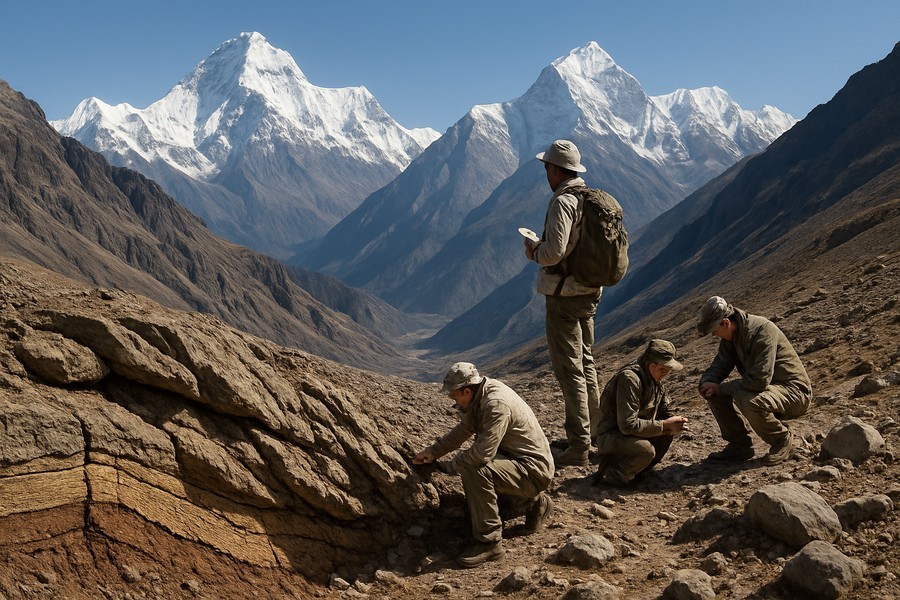
Groundbreaking Findings Redefine Our Understanding of the Himalayas
A long-standing scientific theory about the geological forces that gave rise to the Himalayas, the world's tallest mountain range, is being challenged by new research. The Himalayas were formed about 50 million years ago when the Indian and Asian continents collided, causing the landmass of Tibet to crumple and reduce by approximately 620 miles. This collision resulted in the Indian tectonic plate slipping underneath the Eurasian plate, leading to a doubling of the thickness of the Earth's crust beneath the Himalayas and the Tibetan Plateau, and contributing to their elevation.
Challenging a Century-Old Theory
For the last 100 years, scientists have believed that this increased thickness of the crust was solely responsible for supporting the weight of the Himalayas and the Tibetan Plateau. This idea originated from a study published in 1924, which suggested that the Indian and Asian crusts were stacked on top of each other, extending 45 to 50 miles deep beneath the surface of the Earth.
However, recent research suggests that this theory may not hold up under examination. The reason is that rocks in the crust become molten around 25 miles deep due to extreme heat. As explained by Pietro Sternai, a geophysics professor who led the new study, if you have 70 km of crust, the lower part becomes like yogurt due to the heat, and you can't build a mountain on top of yogurt.
New Evidence Brings About a Paradigm Shift
While some signs have indicated that the old theory may be flawed, most geologists have not questioned it due to the appealing simplicity of a neatly stacked double-thickness crust. However, the new study reveals a game-changing fact: there is a chunk of mantle situated between the Asian and Indian crusts. And this discovery could explain why the Himalayas are so tall and continue to maintain their great height.
The mantle is the layer of the Earth that resides directly beneath the crust. It is denser than the crust and thus, unlike the crust, does not melt at the same temperatures. On the other hand, the crust is so light and buoyant that it behaves like an iceberg, rising higher above the Earth's surface the thicker it gets.
Discovering the Mantle Insert
Sternai and his team came across the mantle insert while simulating the collision between the Asian and Indian continents on a computer. The simulation showed that as the Indian plate began to melt and slip beneath the Eurasian plate, pieces of it rose and attached themselves not to the bottom of the Asian crust, but to the base of the lithosphere, the rigid outer layer of the planet composed of the crust and upper mantle.
This is a fundamental finding, Sternai explained, because it indicates that there is a rigid layer of mantle between the stacked crusts, solidifying the whole structure beneath the Himalayas. The two crusts provide enough buoyancy to keep the region elevated, while the mantle material lends resistance and mechanical strength. In Sternai's words, you've got all the ingredients you need to uplift topography and sustain the weight of the Himalayas and Tibetan plateau.
Validating the New Theory
The researchers then compared their findings with seismic data and information collected directly from rocks. They found that the mantle sandwich in the simulation matched previous evidence that the old theory couldn't explain, co-author Simone Pilia, a geoscience professor, said. Observations that seemed enigmatic are now more easily explained by a model where you have crust, mantle, crust.
While the study presents strong evidence for this model, contradicting the 100-year-old theory is controversial because it has been so widely accepted. However, the results seem plausible and explain several geological peculiarities in the Himalayas. Commenting on the study, Douwe van Hinsbergen, a professor of global tectonics and paleogeography, said that it's a nice new finding and an elegant interpretation. If a continent shoves below another continent, you’d expect a sandwich that consists from top to bottom of crust and mantle lithosphere of the upper plate, and then the crust of the lower plate.
